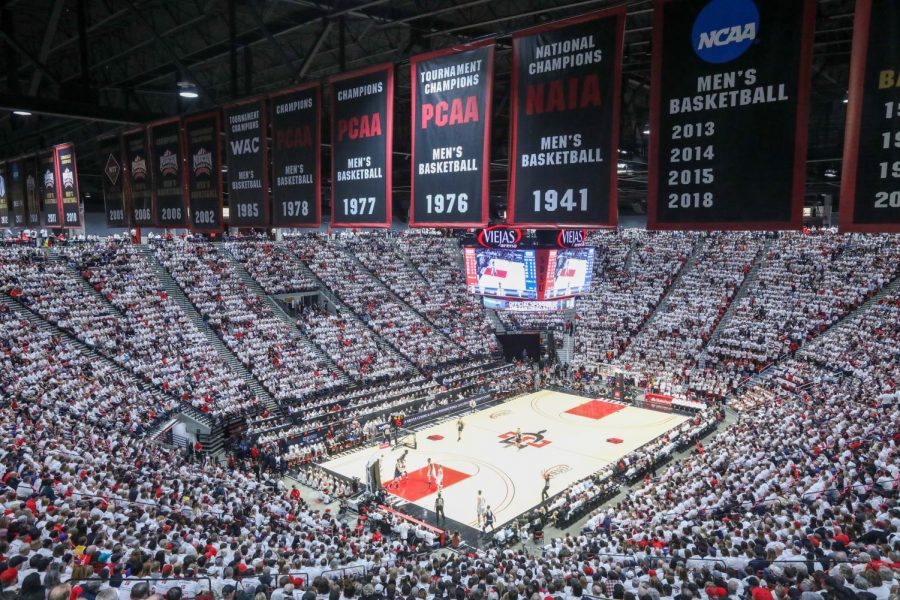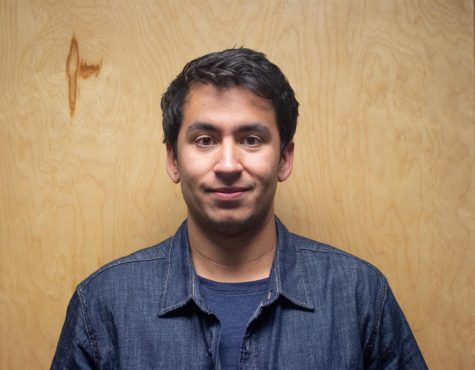Despite the NCAA men’s basketball tournament getting canceled due to the coronavirus pandemic, fans on social media are still finding ways to enjoy the sport they love.
Fans across the internet have taken basketball to the virtual world by running simulations to see who could’ve been crowned champion of March Madness.
So, how did San Diego State men’s basketball fare after a historic season?
It depends on the platform.
Reddit simulation has Aztecs bounced out in first round
On Reddit, the moderators of the college basketball subreddit concocted a 68-team bracket through the website Bracket Matrix and ran it through an artificial intelligence-decided tournament on “College Hoops 2K8,” a video game released by 2K Sports and Visual Arts in 2007.
On their official announcement on March 15, the moderators claimed the video game was selected due to its ability to create custom teams and rosters, which was essential to create the perfect bracket.
San Diego State received an overall team rating of 81, with Malachi Flynn and KJ Feagin graded out as the top two Aztecs with ratings of 81 and 77, respectively.
Time constraints forced the moderators to get crafty to create the ratings. A March 20 update revealed player and team ratings were updated on a day-to-day basis and were calculated via averages, shooting percentages and overall team caliber.
The Aztecs were slotted in as a 2-seed and matched up with 15-seed Eastern Washington. Unfortunately for San Diego State, the AI favored an upset as Eastern Washington defeated the Aztecs 78-68.
In the simulation, Flynn scored 19 points while senior forwards Nolan Narain and Yanni Wetzell finished with double-doubles. However, junior guard Jordan Schakel and sophomore guard Adam Seiko were marked as “DNP- Coach’s Decision.”
Therein lies the problem with the 2K8 simulation.
Moderators admitted they had set eight-man rotations and set some players to zero minutes, but the AI still gave minutes to those players. Whether Schakel and Seiko had been taken out by the AI or by a human moderator is unknown.
Simulating a sweet experience
The Aztecs fared better in a different, yet similar, run.
The Twitter account SimulatinSports took into account the actual results of basketball games until the season was canceled to create a bracket.
However, there was no evidence of the account taking analytical websites such as Kenpom into consideration nor a poll conducted through Twitter for the results.
This time, San Diego State was again a 2-seed but got a different opponent as the 15-seed in 21-10 Nicholls State.
The Colonels hadn’t made the Big Dance since 1998 when they lost to Arizona in the first round 99-60. Against the Aztecs, they also lost in the first round as SDSU rode Wetzell’s 19 points on 8-for-10 shooting for a 96-72 victory.
Next on the docket was Houston, a 7-seed who knocked out Oklahoma with an 87-74 victory. Houston put up a strong fight, even taking a 44-43 lead during the second half.
Much like in real life, one player got hot at the right time and spearheaded an offensive surge. That one player was Flynn, who scored 30 overall points to lead SDSU to the Sweet 16 with a 70-61 victory.
The ride ends for the Scarlet and Black against the 3-seed Louisville.
SimulatinSports spotted SDSU with a 47-34 lead at halftime, but Louisville tied the game to send it into overtime when the Cardinals eliminated the Aztecs 90-83.
While SimulatinSports chose their matches via results, another Twitter account chose to make their simulation as close to perfection as they could.
Combining basketball with analytics and other algorithms
Simply known as “2020 NCAA Tournament Simulation” on Twitter, the group told The Daily Aztec it simply “wanted to figure out a way to predict what would have happened in the NCAA tournament.”
Using an advanced algorithm, the simulation looked to provide the most accuracy to its bracket for their audience while using ESPN’s Joe Lunardi’s bracket to determine the teams and seeds.
With little clarity on brackets, this simulation trusted Lunardi’s bracket the most due to the ESPN reporter’s status as a bracketologist.
“Joe Lunardi is one of the most trusted bracketologists out there and posts updated brackets on ESPN,” the simulation’s Twitter account said in a direct message. “We decided to use Lunardi’s most recent and updated bracket primarily because it was the most updated bracket at that period in time.”
Using an advanced algorithm created by a team of people that include a mathematics major and information systems graduate data was withdrawn from sources like ESPN, Kenpom, and Synergy Sports.
One member of the group plugs the data into the algorithm while another inputs the numbers into one simulated college basketball game.
“In basic terms, we take statistical data from multiple sources,” the account said. “The data from these sources are given to our mathematician who has created an algorithm that replicates team and player tendencies for realistic statistics.”
In his bracket, Lunardi placed SDSU in the West Region as a 2-seed.
Their opponent?
Fifteen-seed UC Irvine of the Big West, who play just an hour away from SDSU.
In a highly contested game that would have riled up SDSU’s student section “The Show,” SDSU narrowly dodged an upset against the Anteaters with a 60-56 win. In the match, Flynn was predicted to score 19 points and grab four rebounds.
However, according to the algorithm, the Aztecs would be taken off the dance floor in the next round by the 7-seed Arizona Wildcats, who denied the Aztecs a Sweet 16 appearance by handing them a 68-61 loss.
SDSU didn’t have the greatest of luck in the simulations, but it did win the gold in one simulation.
Not a March Madness tournament, but a Marble Madness tournament.
The appropriately named “Marble Madness” Twitter account combined the sport of marble racing, mixed it with college basketball and simulated the entire NCAA Tournament.
A pulley system dropped two marbles at a time into a brightly colored obstacle course consisting of plastic pipes and four wide funnels.
Represented by a black marble, the 2-seed SDSU rolled past UC Irvine, Arizona, Eastern Washington and Oregon to reach the championship game.
Against Wisconsin, the race was tight as both marbles jockeyed for position. However, the black Aztec marble took a lead and never looked back, leaving Wisconsin in the dust to win the Marble Madness Championship.
So, why go through simulating college basketball games that won’t happen in the real world?
The 2020 NCAA Tournament Simulation Twitter account said it best.
“It has also been amazing to see how passionate college basketball fans truly are,” the simulation’s Twitter account said. “The fans have really brought the fun and life into this simulation.”
That has certainly been the case for SDSU basketball fans. Whether it be a video game or marbles, nothing will stop fans from cheering on their Aztecs.










